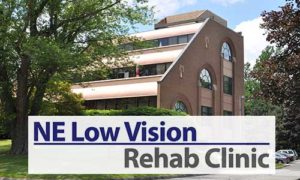Low Vision Rehabilitation Referral Guidelines for Eye Care Professionals
There comes a point for some patients with vision loss that all treatment options have been exhausted. Although follow-up is still critically important, it feels a bit hopeless that there are no more medicines, surgeries, injections or eyeglasses that can help to save or improve their eyesight and difficult conversations must be had. At these times Low Vision Rehabilitation can be a critical help for patients with vision loss who feel their world is closing in around them.
Low Vision Rehabilitation helps people with vision loss maximize the vision they do have, increase their independence and improve their quality of life.
Who Can Benefit From Low Vision Rehabilitation?
Anyone with vision loss can benefit from Low Vision Rehabilitation. This includes people with hereditary or genetic diagnoses that render them:
- Mildly Visually Impaired
- Moderately Visually Impaired
- Severely Visually Impaired
- Legally Blind
- Totally Blind
How Low Vision Rehabilitation Helps Patients with Vision Loss
Low Vision Rehabilitation helps people with vision loss to see better at all distances from up close to objects or people that are far away and everywhere in between.
Low Vision Rehab can also help people with vision loss improve their quality of life by giving them greater independence and enabling them to enjoy everyday activities and even hobbies again.
What the Patient with Vision Loss Can Expect From Low Vision Rehabilitation
Patient’s Expectations can include but are not limited to:
- Improved functional visual outcomes at near/intermediate and distance addressing:
- reading and writing demands
- computer/tablet and hobby demands at arm’s length
- television/school or meeting distance vision demands
- A targeted examination and treatment plan and tools to address other visual and systemic anomalies such as:
- balance and vestibular deficits
- light sensitivity, headaches and intermittent double vision induced from binocular vision problems
- reading challenges
- visual processing deficits
What the Referring Eye Doctor Can Expect From Low Vision Rehabilitation
In addition to all the above that the patient receives from Low Vision Rehabilitation, the Eye Doctor also gets relief from the strain of longer exam times for Low Vision eye examinations in their clinical scheduling.
What the Comprehensive Low Vision Eye Examination and Technology Assessment Includes
In our Comprehensive Low Vision Eye Examination and Technology Assessments, we:
-
- Reinforce the patient’s understanding of their ocular anatomy and pathology as it relates to functional vision.
- Locate the patient’s Preferred Retinal Locus (PRL) or “sweet spot” in their remaining vision.
- Teach the patient to use their PRL or sweet spot in their vision to see: facial features with more clarity, reduce the amount of magnification needed at near/intermediate and distance.
- Teach the patient to more consistently access their remaining vision or visual field improving all functional outcomes.
- Reduce or eliminate the patient’s frustration with inconsistent or vacillating functional vision.
- Complement and enhance all functional outcomes with prescribed optical spectacles with customized tints and lenses and prescribed optical devices.
- Provide Advanced Technology Assessments and Recommendations
- Provide Training and Education in proper use of all prescribed spectacles, optical devices and advanced technology devices and recommendations.
What You Will Need to Send With Your Patient
In order for Low Vision Rehabilitation to be a successful for your patient with vision loss, when you refer them, you should send:
- Current Comprehensive Eye Examination (within the past 12 months at most, most current otherwise)
- Visual Field Testing Results
- Retinal Photography; Optic Nerve imaging and analysis
- Imaging: OCT; A or B scan Ultrasound
- CAT Scan, MRI; SPECT SCAN
- All Other Auxiliary diagnostic or serial/routine testing results
What Eye Doctors Receive After Patients Visit Our Low Vision Rehabilitation Clinic
At our Low Vision Rehab Clinic, we believe it is important to partner with a patient’s eye care professionals and to keep them informed throughout the process. After a visit to our Low Vision Rehab Clinic, we send back with your patient the following
- Cover Letter summarizing our Assessment, Plan and Recommendations.
- A copy of our Comprehensive Low Vision Eye Examination
- A follow-up three months later with all functional outcomes reported
 What Makes The NELV&B Low Vision Rehab Clinic Unique?
What Makes The NELV&B Low Vision Rehab Clinic Unique?
Not all Low Vision Rehabilitation Clinics are the same. At the New England Low Vision and Blindness Rehabilitation Clinic we take the time needed with each patient to help them meet their goals. We also have the most experienced staff, comprehensive training and offer every low vision and blindness technology from Every major supplier all under one roof.
Unique to Our New England Low Vision and Blindness Rehabilitation Clinic are:
- A 2-hour Initial Comprehensive Eye Examination and Training
- A 2-hour Follow-up Examination and Training at Three month intervals
- Technology Assessment, Recommendations and Training
- In- Home Assessments and Training
- A Community of Visually Impaired and patients and their loved ones….providing on-going support and resources
- A Staff which has for decades specialized (and leads), both regionally and nationally, in caring for patients with Visual Impairment.
Call us now at 888-211-6933 or email info@nelowvision.com to learn more about our Low Vision Rehabilitation Clinic or to make a patient referral.





